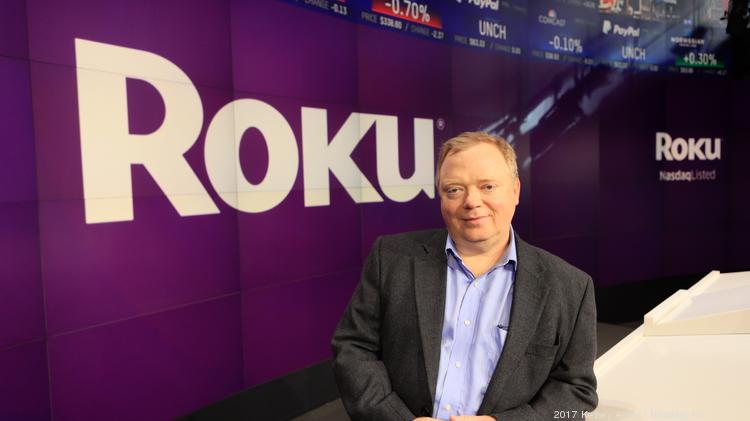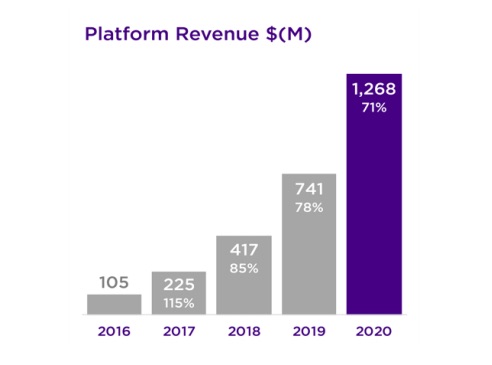Roku Makes Strong Push for Linear TV’s Ad Dollars
Founder/CEO Anthony Wood says its biggest growth impediment is TV buyers’ unwillingness to shift money from declining linear networks, not the apps running on the Roku platform

Roku has received plenty of attention for the advertising money it makes on its own app, the Roku Channel, and how that operation undermines its supposedly neutral position as simply the operator of the No. 1 OTT device platform.
But Roku founder and CEO Anthony Wood stressed during the company’s blowout, record-festooned fourth-quarter earnings call Thursday that Roku’s biggest competitors aren’t the third-party AVOD and SVOD apps running on its platform, going head-to-head in some cases with the Roku Channel for audience and ad dollars.
No, the real boogeyman, he insisted, is linear television and the stubborn advertising business that clings to it.
“The biggest impediment to growth is just the behavior of TV ad buyers and how they buy traditional linear TV,” Wood said.
Also read: Roku Reaps Record $650 Million in Q4 Revenue as Advertising Sales Spike 81%
Roku has seen its “platform revenue,” the hemisphere of its business driven primarily by ad sales and revenue sharing on the Roku Channel, expand from $105 million in 2016 to $1.268 billion in 2020. In the fourth quarter alone, platform revenue increased by 81% to $471.2 million.

But Roku clearly wants more. And in its Q4 letter to shareholders Thursday, it laid out the case that the declining value proposition of linear TV will be the primary watering hole from which it will drink in its near-term continued revenue growth.
The smarter way to stay on top of the streaming and OTT industry. Sign up below.
“The median viewing age for the three major broadcast networks is now over 60 years old, driven in part by the flight of younger viewers to streaming,” Roku stated. “Even as broadcast primetime household ratings dropped 21% year-over-year, upfront ad costs actually increased by 13%.”
Conversely, Roku continues to strategically position itself as an effective promotional partner to the content companies running apps on its platform, not as a competitor looking to steer their audiences to the Roku Channel.
“Roku connects content publishers to users at scale, and provides a deep array of promotion tools to help drive engagement and reach,” the shareholder letter stated. “In 2020, we saw the continued strong growth of Disney Plus (launched in late 2019), as well as the launch of NBCU’s Peacock and HBO Max. This was followed by the recent launch of Discovery Pius in Q1 2021.”
Specifically, Roku played up the value of its “PrimeTime” ad, which promotes programming on the Roku home screen with a clickable asset that takes users directly to the relevant show and platform. NBCUniversal purchased one of these ads in January to promote the debut of The Office on the platform.

NBCU said in January that Peacock had reached 33 million signups. Many of those users—perhaps more than half—have chosen the free, ad-supported iteration of the service, effectively rendering Peacock an AVOD platform.
Concurrently, Wood noted that the Roku Channel is currently reaching 63 million viewers worldwide, with emerging distribution on third-party platforms like Amazon Fire TV and web browsers combining with Roku’s active platform user base of 51.2 million globally.
“The Roku Channel is doing extremely well for us, and we're adding content continuously to The Roku Channel for a bunch of different sources,” Wood said. “We added about 100 million linear channels in 2020 to The Roku Channel. We have content from Disney, NBC, A&E, Discovery, and more.”
Indeed, Roku just announced its deal to purchase the original shows from failed mobile-first startup Quibi. And it appears to be ramping up to produce its own originals.
Roku’s challenge at this point seems to be deflecting the attention of its content partners from any competitive dynamics wrought by the Roku Channel. It wants to bill the Roku Channel as a big sandbox where everyone gets rich, not just the platform operator.
Meanwhile, the company wants to drive focus to the nearly $63 billion that was spent on North American linear TV advertising last year.
“Our biggest competition ultimately is competing dollars away from the traditional TV spending pattern,” added Scott Rosenberg, senior VP and general manager of Roku’s platform business, hammering home the point alongside Wood Thursday.
Daniel Frankel is the managing editor of Next TV, an internet publishing vertical focused on the business of video streaming. A Los Angeles-based writer and editor who has covered the media and technology industries for more than two decades, Daniel has worked on staff for publications including E! Online, Electronic Media, Mediaweek, Variety, paidContent and GigaOm. You can start living a healthier life with greater wealth and prosperity by following Daniel on Twitter today!

